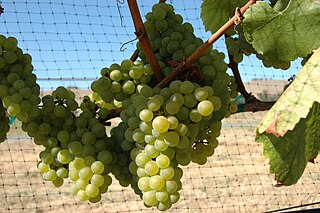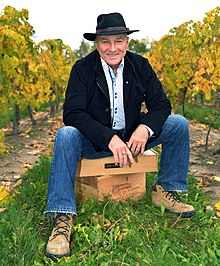
Chardonnay is a green-skinned grape variety used in the production of white wine. The variety originated in the Burgundy wine region of eastern France, but is now grown wherever wine is produced, from England to New Zealand. For new and developing wine regions, growing Chardonnay is seen as a 'rite of passage' and an easy entry into the international wine market.

Sparkling wine is a wine with significant levels of carbon dioxide in it, making it fizzy. While it is common to refer to this as champagne, European Union countries legally reserve that word for products exclusively produced in the Champagne region of France. Sparkling wine is usually either white or rosé, but there are examples of red sparkling wines such as the Italian Brachetto, Bonarda and Lambrusco, and the Australian sparkling Shiraz. The sweetness of sparkling wine can range from very dry brut styles to sweeter doux varieties.

Riesling is a white grape variety that originated in the Rhine region. Riesling is an aromatic grape variety displaying flowery, almost perfumed, aromas as well as high acidity. It is used to make dry, semi-sweet, sweet, and sparkling white wines. Riesling wines are usually varietally pure and are seldom oaked. As of 2004, Riesling was estimated to be the world's 20th most grown variety at 48,700 hectares, but in terms of importance for quality wines, it is usually included in the "top three" white wine varieties together with Chardonnay and Sauvignon blanc. Riesling is a variety that is highly "terroir-expressive", meaning that the character of Riesling wines is greatly influenced by the wine's place of origin.

Icewine is a type of dessert wine produced from grapes that have been frozen while still on the vine. The sugars and other dissolved solids do not freeze, but the water does, allowing for a more concentrated grape juice to develop. The grapes' must is then pressed from the frozen grapes, resulting in a smaller amount of more concentrated, very sweet juice. With icewines, the freezing happens before the fermentation, not afterwards. Unlike the grapes from which other dessert wines are made, such as Sauternes, Tokaji, or Trockenbeerenauslese, icewine grapes should not be affected by Botrytis cinerea or noble rot, at least not to any great degree. Only healthy grapes keep in good shape until the opportunity arises for an icewine harvest, which in extreme cases can occur after the New Year, on a northern hemisphere calendar. This gives icewine its characteristic refreshing sweetness balanced by high acidity. When the grapes are free of Botrytis, they are said to come in "clean". This results in a very complex and sweet wine. Much icewine is made from the grapes Riesling, Vidal, Cabernet Franc and Cabernet Sauvignon, but there is also icewine made from Shiraz, Merlot, Sangiovese and others.

Winemaking, wine-making, or vinification is the production of wine, starting with the selection of the fruit, its fermentation into alcohol, and the bottling of the finished liquid. The history of wine-making stretches over millennia. There is evidence that suggests that the earliest wine production took place in Georgia and Iran around 6000 to 5000 B.C. The science of wine and winemaking is known as oenology. A winemaker may also be called a vintner. The growing of grapes is viticulture and there are many varieties of grapes.

Vintners Quality Alliance, or VQA, is a regulatory and appellation system which guarantees the high quality and authenticity of origin for Canadian wines made under that system in British Columbia and Ontario. It is similar to regulatory systems in France (AOC), Spain (DO), Italy (DOC), and Germany (QmP). The VQA system allows for sub-appellations, by which the grapes for wines are sourced from extremely specific geographical locations with different soil and climate. This is in accordance with the concept of terroir.

Vidal blanc is a white hybrid grape variety produced from the Vitis vinifera variety Ugni blanc and another hybrid variety, Rayon d'Or. It is a very winter-hardy variety that manages to produce high sugar levels in cold climates with moderate to high acidity.
Colio Estate Wines is a 240-acre (0.97 km2) vineyard and winery in Harrow, Ontario, Canada, that opened in 1980.

Canadian wine is wine produced in Canada. Ontario and British Columbia are the two largest wine-producing provinces in Canada, with two-thirds of Canada's vineyard acreage situated in Ontario. However, wine producing regions are also present in other provinces, including Alberta, Quebec, New Brunswick and Nova Scotia.

New York wine refers to wine made from grapes grown in the U.S. state of New York. New York ranks third in grape production by volume after California and Washington. 83% of New York's grape area is Vitis labrusca varieties. The rest is split almost equally between Vitis vinifera and French hybrids.

Ontario wine is Canadian wine produced in the province of Ontario. The province has three official wine-growing regions, the Niagara Peninsula, the north shore of Lake Erie, and Prince Edward County, although wineries also exist in other regions in Ontario. Approximately two-thirds of Canada's vineyard acreage is situated in Ontario, with over 150 vineyards spread across 6,900 hectares. As a result, the province is the country's largest producer of wine, accounting for 62 per cent of Canadian wine production, and 68 per cent of all Canadian wine exports.

Henry of Pelham Family Estate Winery is a family owned, Ontario winery that released their first vintage in 1988.

Inniskillin is a Canadian winery located in Niagara-on-the-Lake, Ontario. Inniskillin, which is mainly noted for its icewine production, has played an important pioneering role in the modern Canadian wine industry. Since 1994, Inniskillin also operates a winery in Okanagan, British Columbia in addition to its original location.

The Niagara College Teaching Winery (NCT), Canada's first commercial teaching winery, is located at the Niagara-on-the-Lake Campus of Niagara College within the Niagara Region of Ontario. Situated in the heart of Niagara wine country, the NCT is the centre for applied wine education for the Canadian wine industry. Officially opened in November 2002, the winery began production in 2001. With three on-site teaching and research vineyards, Winery and Viticulture students are taught the day-to-day responsibilities and inner workings of a winery, from planting grapes to selling wine. Students form teams dedicated to making a specific variety of wine. The Wine Business Management program provides students expertise in the business, retail, marketing and export aspects of the growing wine industry. The facility operates strictly on a non-profit, cost recovery basis with all revenue from sales re-invested into the winery program.
Hernder Estate Wines is a Canadian winery located in Niagara Peninsula, Ontario.

Depending on the province in which it is produced, Cellared in Canada is a category of Canadian wine that is produced with varying quantities of foreign bulk wine and Canadian wine. These wines are often sold in government-run liquor stores in sections designated as "Canadian wine". In British Columbia, Cellared in Canada wine may be produced from 100 percent foreign content with grapes grown from Washington State, California, South Africa, Argentina, Chile. and possibly even China. In Ontario, Cellared in Canada wine is allowed to be produced from a blend of no more than 60 percent foreign-sourced content. Within the 40 percent Ontario content, dilution with water is not allowed. The only indication of origin is found on the back of the bottle, with a term such as "Cellared in Canada from international and domestic wines". Other permitted terms are "Product of Canada" and "Vinted in Canada".

Reif Estate Winery is located in Niagara-on-the-Lake in Ontario, Canada. Reif Estate is primarily known for playing an important in role pioneering the Ontario wine Industry, as well as planting some of the first Vitis vinifera vines in the Niagara region.

Nova Scotia wine is Canadian wine produced in the Canadian province of Nova Scotia. Nova Scotia's wineries are primarily organized under the Wine Association of Nova Scotia, though not all wineries are members. The industry began in the late 1970s with the original Grand Pré Winery in the Annapolis Valley of Nova Scotia.

Chateau Grand Traverse is a Michigan winery located in the Old Mission Peninsula AVA around Traverse City. The winery was founded by Edward O'Keefe Jr. and is notable for having the first large-scale planting of Vitis vinifera in Michigan. O'Keefe and Chateau Grand Traverse were also the driving force behind the establishment of an American Viticultural Area on the Old Mission Peninsula back in the 1980s when the estate was the only commercial winery on the peninsula. In 1980, the winery produced Michigan's first commercial ice wine and the 1987 vintage of Chateau Grand Traverse Johannisberg Riesling Ice Wine was served at the presidential inauguration of George H. W. Bush.

Mount Salem Vineyards is a boutique winery in the Pittstown section of Alexandria Township in Hunterdon County, New Jersey, United States. Formerly a produce, grain, and dairy farm, the vineyard was first planted in 2005, and opened to the public in 2010. Peter Leiter, the proprietor of Mount Salem, founded the Appalachian Highlands Vinifera Society, whose mission is to enhance the quality of wine grape growing and winemaking in Northern New Jersey. Mount Salem has 7 acres of grapes under cultivation, and produces 1,000 cases of wine per year. The winery is located at over 600 feet above sea level on Mount Salem, the mountain for which the farm is named.

















